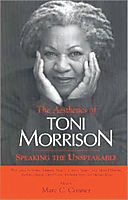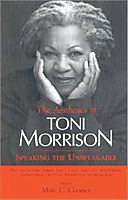African American Literary Tradition and Toni Morrison's Aesthetic Perspectives

African American Literary Tradition
African American writers are preoccupied with the notion of blacks as marginalized and black literature as the non-canonical literature. Their literary careers start with the crisis of their identity as the respectable American citizens. They strive to redefine white/black hierarchy of mainstream discourse. Mainstream hegemonic discourse always undermines black's presence in the making of American literature and culture.
Toni Morrison's Aesthetic Perspectives
The first African American writer to win the Nobel Prize for literature in 1993, Toni Morrison is a leading voice in current debates about the construction of race and black marginality in literature and culture. As a prominent writer of the age she refuses to allow race to be marginalized in literary discourse. Throughout her writing Morrison uses narrative forms to express African Americans' dislocated, marginalized oral tradition, and culture, and reclaim African American's historical experiences.
 |
| The Book Photo:Courtesy |
Morrison critiques the mainstream thinking and acclaims that black writers and black characters are the relative means by which text demonstrates to be human and superior. Imagination is possible in the presence of black characters and black contents. At the same time talking African discourse is inferior and submissive tends to impoverish cultural interpretation of reality. Morrison questions the validity and vulnerability of a set of assumptions conventionally accepted and taken for granted among literary historians and critics.
Africanist presence, in a constitutive part in the entire history has been rejected. Morrison in Playing in the Dark: Whiteness and Literary Imagination proposes, "The contemplating of this black presence in central to any understanding of our national literature and should not be permitted to hover at the margins of the literary imagination." Morrison argues that American culture is built on, premised by, and always includes, the presence if blacks' as slaves and outsiders.
She likens the unwillingness of academics in a racist society to see the place of Africanism in literature and to the centuries of unwillingness to see a favourite discourse, concerns and identity. She posits whiteness as the 'Other' of blackness, a dialectical pair, each term both creates and excludes the other: no freedom without slavery, no white without black.
The major themes of Toni Morrison's writing is to redefine the notion of white American canonical texts and their idea of African American writing as being non-canonical or inferior. She demonstrates the idea of racial superiority and hegemonic culture in her writings. Morrison, in the preface of her critical work Playing in the Dark: Whiteness and Literary Imagination says she is "struggling with and through a language that can powerfully evoke and enforce hidden signs of racial superiority, cultural hegemony and dismissive 'Othering' of people and language which by no means marginal or already and completely known and knowable in my work."
Toni Morrison decenters the whiteness and its domination over blackness in America. She opines that whiteness always sees black or Afro-American [people as dead, impotent or, under complete control but this is lacking very important part of black people and their construction of social realities. Unlike the notions of white American Morrison claims that black slavery enriched the country's creative possibilities.
Morrison in "Afro-American Presence in American Literature" figures out that race does not exist (Bloom 203). When race does not exist there is no question of racial superiority and inferiority as such. The notion of white American as being superior is not true. She says that those who created the hierarchy of race do not accept that there is indeed Afro-American culture. Afro-American culture exists but it is poorly recognized or understood (Bloom 203).
Morrison focuses that contemporary Afro-American literature addresses the attitudes that have silenced the autonomy of Afro-American literature since the seventh century. The change of "There is no Afro-American art" is buried by the rediscoveries of Afro-Americans' works and their appropriateness to the present context (Bloom 208). Afro-American literature counters the label of Afro-American literature being inferior so that non-canonical texts can be incorporated into existing.
It is clear that Morrison's writing is different from that of mainstream white discourse, which always observes that African American literature is subsidiary product. Her intention, thorough her writing , is to reinterpret and redefine the hidden, dislocated and alienated Afro-American presence in American mainstream discourse and claim that Afro-Americans are no more inferior human beings.
Toni Morrison's fiction demonstrates a central interest in the issues of boundary, attachment, and separation. Her characters experience themselves as wounded, or imprisoned by racial and economic divisions within American culture. The boundaries that circumscribe black people are not only the prejudices and restrictions that bar their entry into the mainstream but the psychological ones they internalize as they develop in a social structure that historically has excluded them. Toni Morrison draws from a rich store of black oral tradition as well as from her own imaginative angle of vision to illuminate the potentialities for both annihilation and transcendence within black experience.
Black lore, black music, black language and all the myths and rituals of black culture are the most prominent elements in Toni Morrison's writing. She feels a strong connection to ancestors because they were the culture bearers. She thinks that it is the responsibility of African American writers to dig out that annihilated history and secure the importance of it in the making of American civilization.
Toni Morrison's first novel, The Bluest Eye (1970) examines the experiences of a young black girl as she copes up with the ideal of beauty and the reality if violence within the black community. She tries to demonstrate that people hurt each other when they are chained to circumstances of poverty and low social status. The ideal experience of white world and the actual experience of black people is portrayed in the novel. After being raped by her drunken father, deceived into believing god had miraculously given her the bluest eye she prayed for, suffering a miscarriage and being ridiculed by the other children Pacola Breedlove loses her sanity. Pacola's determination to achieve beauty and acceptance by acquiring blue eye never succeeds.
Morrison's second novel Sula (1973) is about the theme of the friendship of two black girls. One Nel Wright follows the pattern of life society has laid out for her, and the other, Sula Peace, tries to create her own pattern to achieve her own self. It is not only about Nel Wright ad Sula Peace but also about the cultures that spawn them. Her third novel Song of Solomon (1977) basically draws upon the concern for the quest for identity of a black family, which is disinherited and has lost its name in black America. Morrison presents her concern for African Americans and their black tradition, which is disregarded and marginalized in America.
In her fourth novel Tar Baby (1981) a successful black model and a young black male who rejects middle-class American values are at centre stage in a work that examines the relationship between men and women, as well as between blacks and whites. Her fifth novel Beloved (1987) is set in rural Ohio after civil war. It centers on Sethe Suggs, proud and beautiful woman, who escaped from slavery and kills her own daughter to save her from the torments of it but is haunted by its heritage. It unearths the historical realities of horrifying experiences during Middle Passage, Slavery, Emancipation and its aftermath.
Morrison's Jazz (1992) is based on the theme of music in the lives of her characters. It is a manifestation of the conditions of life among migratory Negroes, their family love, romantic love and desire. Jazz describes the consequences that result from migration, integration and geographic dislocation.
Toni Morrison ranks among the most highly regarded and widely read fiction writers and cultural critics in America. As a critic she refuses to allow race to be relegated to the margins of literary discourse. She focuses on the importance of African American's oral and musical culture and to reclaim black historical experiences. Morrison says that African American have rediscovered texts that have long been suppressed or ignored, have sought to make places for African American writing within the canon, and have developed ways of interpreting these works.
Morrison recalls the ubiquitousness of African American culture rituals in her childhood and adolescence; the music, folklore, ghost stories, dreams, signs and variations that are so vividly evoked in her fictions have been shaping and empowering presence in her life as well. The impact of these forces in her life has inspired her to capture the qualities of African American cultural expression in her writing. Morrison has described the influence of oral tradition, call and response, jazz and dance in her narratives. Yet the presence of myth, enchantment, and folk practices in her work never offers an escape from the sociopolitical conditions that have shaped lives of African Americans. Cultural dislocation, migration and urbanization provide inescapable contexts within which her explorations of African American past are located.
Khem Guragain
The author is a lecturer in Ratna Rayja Laxmi Campus, Tribhuvan University, Kathmandu, Nepal
